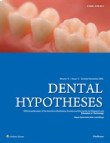فهرست مطالب
Dental Hypotheses
Volume:3 Issue: 1, Jan-Mar 2012
- تاریخ انتشار: 1390/05/18
- تعداد عناوین: 6
-
-
Page 5IntroductionA periapical scar represents a clinically asymptomatic, non-progressive, small, periapical radiolucency in patients with a previously well-performed root canal treatment. The hypothesis: We introduce a hypothesis that periapical scar formation is caused by osseoinhibitory molecular signaling from the epithelial cell rests of Malassez. Evaluation of the hypothesis: When epithelial cell rests of Malassez are present in teeth with an infected root canal system, a periapical cyst develops, whereas in the case of a treated root canal system infection, periapical inflammation is diminished and the periapical leasion heals until the regeneration process reaches the apical part of the tooth where epithelial cell rests of Malassez are present. Cytokines cause rapidly progressive defensive fibroproduction and scar formation, in which osteoblasts cannot differentiate into bone.Keywords: Apical scar, Endodontics, Periodontitis, Tooth
-
Page 16IntroductionBacteria colonize a variety of surfaces of the human body. The bacterial diversity in the oral cavity is estimated to be more than 700 different species. The oral cavity is home to microbial communities, with important implications for human health and disease. Oral microbial flora is responsible for two major human infectious diseases of the oral cavity, dental caries and periodontal diseases. From the clinical samples, previously, using polymerase chain reaction-based denaturing gradient gel electrophoresis (PCRDGGE) technique, we found a significantly greater diversity of oral microbes in caries-free individuals compared with caries-active individuals.The hypothesis: We hypothesize that a greater diversity of indigenous bacteria inhabits a healthy oral environment, and that a significant proportion of oral biota may be absent, suppressed, or replaced in a periodontal diseases environment.Evaluation of the hypothesis: The microbiota undergoes a transition from a commensal to a pathogenic relationship with the host due to factors that trigger a shift in the proportions of resident microorganisms. If our hypothesis is true, many techniques which were used to detect the oral bacterial diversity can be used in diagnosis and prognosis of periodontal diseases.Keywords: Microbial diversity, Periodontal diseases
-
Page 23IntroductionIndividuals with Intellectual Disabilities (ID) constitute a unique but heterogeneous population, which includes a great variety of mental and developmental disorders, as well as congenital syndromes. Nowadays, many persons with mild or moderate ID, with specific training, can make considerable efforts to improve their lives, by having a job in either open or supported employment. On the other hand, since dental caries and periodontal diseases are among the most common secondary conditions affecting people with ID, oral diseases may detract the quality of life from disabled persons.The hypothesis: Employment (sheltered workshop, open or supported employment) of persons with ID, may enable these individuals to improve their oral health status, attitudes and behavior, compared to the ID individuals who are not working, due to the development of specific socio-emotional characteristics and dexterities.Evaluation of the hypothesis: According to previous reports, employed people with ID demonstrated better self-esteem and greater autonomy, more satisfaction with their vocational/non-vocational activities and higher quality of life.Keywords: Intellectual Disabilities, Supported employment, Oral health status, Behavior, Dental care, Oral preventive programs
-
Revascularization of Immature Necrotic Teeth: Platelet rich Fibrin an Edge over Platelet rich PlasmaPage 29IntroductionRevascularization is one such entity that has found itsclinical application in the field of endodontics for the management of immature permanent necrotic teeth. The protocols for revascularization of such teeth focus especially on delivery of stem cells and scaffolds in a nonsurgical manner rather than concentrated growth micro molecules.The hypothesis: This article proposes the role of platelet concentrates such as platelet rich fibrin (PRF) and platelet rich plasma (PRP) in accelerating the regenerative process in such teeth. PRF unlike PRP is associated with slow, continuous and substantial release of morphogens. It is hypothesized further if PRF instead of PRP when placed through immature apices in an orthograde manner can open newer gates for fast and controlled growth in young, necrotic, non-infected teeth.Evaluation of the hypothesis: Enhancement of the healing kinetics can be evaluated by change in size of periapical radiolucency, thickness of the dentinal walls, root elongation and apical closure compared between preoperative and postoperative standardized two dimensional/three dimensional radiographs taken on regular follow ups.Keywords: Revascularization, Growth factors, Morphogens, Stem cells, Scaffold, Platelet rich fibrin, Platelet rich plasma
-
Page 39Over the last twenty-seven years, the evaluation of practice man-agement in dental schools has been documented by three studies. In twenty-seven years the teaching of practice management has been influenced by changes in the definition of practice manage-ment, resources available to dental schools, technology, changes in accreditation standards and, more recently, the influence of corpora-tions marketing to dental students. In an effort to determine what resources dental schools are utilizing to teach practice management, fifty-seven schools were contacted, and fifty faculty members with teaching responsibilities were identi-fied. An on-line email survey was administered and results reported at the 2011 meeting of the American Dental Education Association Section on Practice Management. At the section meeting breakout groups discussed two questions. First, identify innovative tools, methods and ideas in the area of practice management. Second, what changes may be necessary to meet recently updated accredi-tation standards 2-17 through 2-19. The recommendations of the breakout groups are presented in detail.


